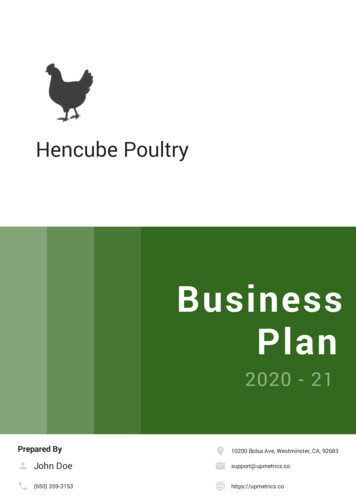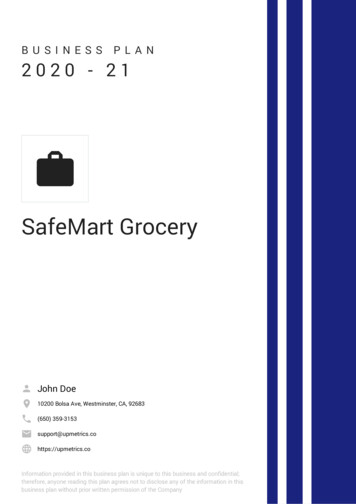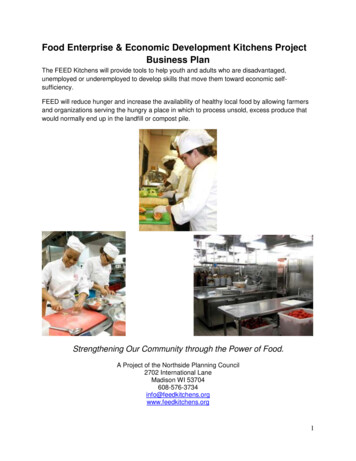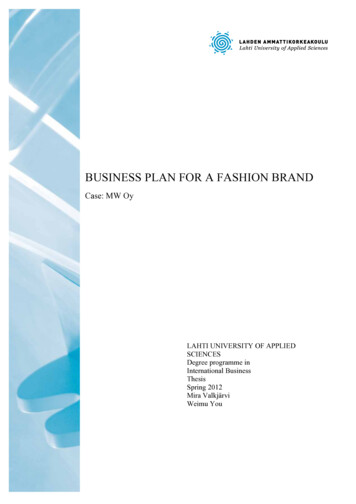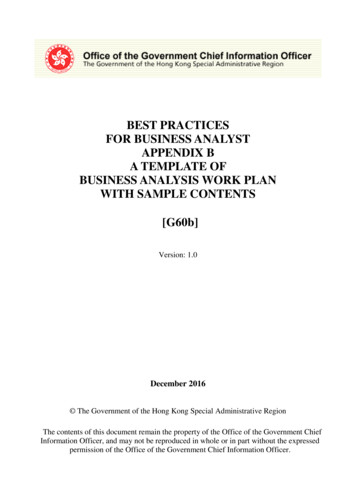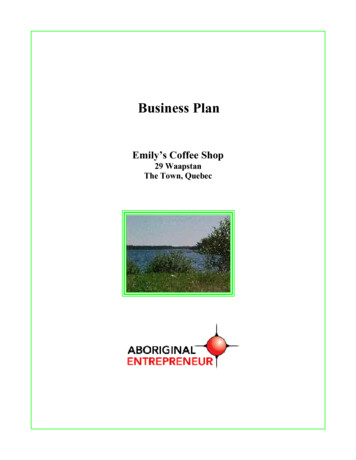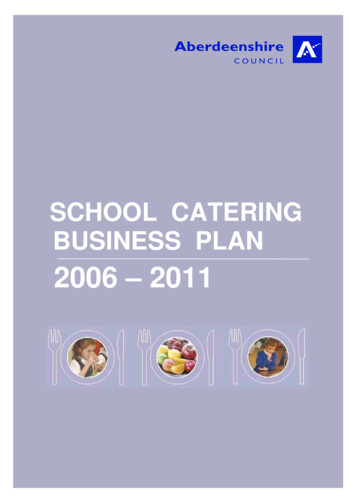
Transcription
SCHOOL CATERINGBUSINESS PLAN2006 – 20111
INDEXPage1.Introduction31.11.21.31.43344Purpose of the PlanBackgroundAims of the Catering ServiceWider Context2.Key Current Activities and Business Level63.Environment in Which We Operate83.13.23.38894.CompetitionGovernment and Council PolicyOtherResources114.14.21112Management and PersonnelFinance5.Performance and Quality Standards136.Strategic Development146.16.26.3141617Service TargetsThe Marketing PlanTraining and DevelopmentAppendix 1 - Planning & Environmental Services OrganogramAppendix 2 - Training Plan / ScheduleAppendix 3 - Three Year Budget2
1.INTRODUCTION1.1Purpose of the PlanThe purpose of this plan is to set the direction in which the Service aims toprogress over the next five years and to give staff and others with an interest init an understanding of the purpose and the environment in which the serviceoperates.1.2BackgroundThe school catering service operates with an expenditure of approximately 7.90 million, the actual turnover at 7.92 million (2004/05) and this service isexpected to show a break-even position over its core activities.The major recent influences on the service have included: Best Value Review of the Service in 2000. The removal of the Client/Contractor split, the demise of CommercialServices and the integration of Trading Services into the wider mainstreamCouncil activities. The Scottish Executive’s Initiative Expert Panel report “Hungry for Success– A Whole School Approach to School Meals in Scotland”. A new and improved working relationship between Education and Cateringthat has driven the Hungry for Success agenda forward making significantprogress to date.The Council’s Scrutiny & Audit Committee carried out a full investigation intothe School Meals Service in 2003/04 and after the publication of their report,the Council adopted their recommendations and the recommendations ofHungry for Success as key objectives for the Catering Service.Since 1 April 2003, Council’s are required to report on ‘significant tradingactivities’ in their accounts as laid out in the Local Government Scotland Act2003. ‘A Best Value Approach to Trading Accounts’ (BVACOP) produced byCIPFA and LASAAC provides guidance notes to support adherence to thisrequirement. The Council undertook a review of its activities in Autumn 2003and designated School Catering as a Statutory Trading Account.3
1.3Aims of the Catering ServiceThe principal aim of the Catering Service is to provide a quality service to all itscustomers. The Service will: meet the Council’s policy of providing a universal meal service across allschools by offering menus that are nutritionally balanced with a variety ofdishes to meet customer expectations. These expectations will beestablished through customer research and feedback. support the Council’s Strategic Intention to promote community wellbeing by working with all partners to reduce health inequalities andpromote healthy lifestyles. 1.4meet the requirements of the Education & Recreation Service throughthe mechanism of the Service Level Agreement that was signed off inMay 2005 by both Service Directors. work with schools to develop and encourage a whole-school approachtowards food in schools to improve and enhance the dining experience,maximise meal uptake and de-stigmatise the provision of free schoolmeals. conform to nutrient, quality and quantity standards prescribed underHungry for Success or any replacements approved by Her Majesty’sInspectors of Education (HMIE). use as much locally produced food as possible and source as much ofthat food through local suppliers.Wider ContextThe Scottish Executive’s vision for a healthier Scotland is set out in their policydocuments: Towards a Healthier Scotland (1999); andImproving Health in Scotland – The Challenge (2003)These documents seek to provide leadership and direction from the ScottishExecutive to its partner organisations, NHS Scotland, Local Health Boards,COSLA and individual Local Authorities.The Scottish Health Promoting Schools Unit was set up to have the nationalleadership role, championing, facilitating and supporting the implementation ofthe Health Promoting Schools concept throughout Scotland.In 2002 the Expert Panel set up by the Scottish Executive to look at SchoolMeals published its report entitled “Hungry for Success” and significant fundingwas made available to Local Authorities to assist them to implement the twentythree recommendations. Since 2002 2.828 million has been received through4
Hungry for Success funding and although yet to be confirmed we expectfunding to be in the region of 1.150 million per annum for the next three years.Aberdeenshire Council’s Scrutiny & Audit Committee in their report on thereview of School Catering expressed the view that the School Meals Servicehas the potential to be the largest public health campaign in Aberdeenshire.At the Council’s Policy & Resources Committee of 16 th September 2004, thecommitment was given to revitalising and re-focusing the in-house cateringservice with a clear aim of providing quality school meals to improve children’sdiets and thereby improving public health.5
2.KEY CURRENT ACTIVITES AND BUSINESS LEVELThe level of service is defined in the Service Level Agreement with Education &Recreation. At the end of the financial year 2004/05 the business level was asfollows:–154 PRIMARYSCHOOLS4 SPECIALSCHOOLS17 SECONDARYSCHOOLSSchool Roll of20,051School Roll of260School Roll of15,9751,622,52222,1911,019,085*% uptake43.7446.134.48Pupils entitled to freemeals1603519771% of aid meals to staff72,73373531,358Free meals to staff49,9045,4689,045Paid meals providedto pupilsFree meals to pupils% uptake of thoseentitled to free meals*Meal numbers are calculated by dividing cash income by the average dailymeal allowance equivalent of 1.93Traditionally, the Council has one of the lowest entitlements to free schoolmeals in Scotland with current levels at just under 8%. With an average mealuptake against the school roll of 45%, this means that around 85% of ourcurrent customers choose to pay for the school meals on offer.6
In addition to the provision of a School Catering service, responsibility alsorests with the Service for Catering at the Council’s Headquarters at WoodhillHouse, Aberdeen. The staff cafeteria, Members restaurant and coffee barsoperate with a current turnover of approximately 350,000 and these servicesare provided by 18 staff.Around 70,000 meals are provided for the Housing and Social Work Service for“Meals on Wheels” and Day Care Centres. Volunteers deliver this service andmeals are cooked in various school kitchens.The productivity level in schools is measured by the number of meals servedper labour hour and at 6.61 the Council compares favourably with otherauthorities with a similar rural composition, although comparison on a like-forlike basis is difficult because of differences in how Councils compile the data.A new staffing model has been developed and, subject to agreement with theTrade Unions, will be implemented in the current year ending March 2006. Thiswill allow an annual revision of hours to facilitate maximum efficiency andproductivity.7
3.ENVIRONMENT IN WHICH WE OPERATEThe major factors that affect the operation of the Catering Service are:CompetitionGovernment and Council PolicyOther3.1CompetitionExternal FactorsHome packed lunches brought into schoolLunches taken at home.Local shops, fast-food outlets and mobile vans.Internal FactorsSchool-operated vending machines and tuck shopsOther Education & Recreation operations involving food and drink, e.g. leisureand community centres, enterprise schemes, pupil-run snack bars, tuck shops.3.2Government and Council PolicyExternalEuropean Union Policies & Regulations, e.g. ProcurementStatutory Controls, e.g. Health and Safety, Food Safety, Employment LawGovernment Policy, e.g. Free School Meals Policy, Hungry for SuccessInternalService Level Agreements with the Education & Recreation and Social WorkServicesSpecial needs of individual schoolsCouncil’s Financial Regulations and Scheme of DelegationPromoting healthy lifestyles policy8
3.3OtherPeer PressureChildren at all levels are influenced by what their friends think and the way theybehave – it is not “cool” to eat vegetables, and then in Secondary schools, it is“cool” to go out of school at lunchtime.School EthosThe importance of food in the school day greatly influences the response fromthe pupils and their parents. Attitudes and behaviour of school managementand teachers provide the lead for pupils and determine the extent of the wholeschool approach.FacilitiesMany of our facilities are inadequate and inhibit the Service’s ability to delivergood quality meals efficiently. Queuing remains a major problem, particularly insecondary schools. Key to improving meal uptake and enhancing the diningexperience will be the provision of modern brightly coloured dining rooms.PricingThe price of a two-course meal (currently 1.50) reflects income derived fromcustomers and Council subsidy, and expenditure costs, such as food, labourand other overheads. Price increases in recent years have generally followedthe prevailing level of inflation.Advertising, Marketing and PromotionFor school meal uptake in Aberdeenshire to rise, then successful marketingand promotion of the products will be vital. However, the Service is also upagainst the giants such as Walkers Crisps, Coca Cola and the power of theiradvertising.The recent publicity on school meals in England and Wales has reinforcednegative perceptions of the quality of school meals throughout the UK andgiven insufficient recognition to the rise in standards in Scotland through theHungry for Success initiative. Jamie Oliver and other critics may haveperformed a valuable service by reporting on poor meal quality in schools southof the border, but their negative views have unfortunately seen a decline inmeal uptake in Scottish schools.Parents and PupilsParent and pupil choice and perception of quality of school meals andattractiveness of the dining experience is crucial to attracting and improvingcustomer levels. Regular surveys will continue to play an important part in thedesign and delivery of the service.9
WeatherThe weather plays a significant part in choosing what and where to eat,especially in secondary schools, with increases of 25% common on rainy days,and conversely significant downturn in dry warm weather.10
4.RESOURCES4.1Management and PersonnelThe organisational chart at appendix 1 shows the numbers and grades of staffemployed in the Service plus the Whole Time Equivalent (WTE) value. The Catering Manager has overall day to day responsibility for the controland management of the Catering Service. Three Area Supervisors assist the Manager to carry out this function onan operational level. Each Supervisor has a pool of five relief staff toprovide cover for absences or additional work. They also have a trainerwho deals with the induction of new staff. Each kitchen has a Unit Supervisor who is responsible for the day-to-dayprovision of catering in schools under their control. The Operational Support Officer is responsible for purchasing andsupplies and the introduction of new products. The Administrative Officer heads the team of clerical support who processpayroll records, income data and payment of invoices. The Promotions Officer promotes and markets the service, runs specialcampaigns and trials new products and initiatives. A short-term Project Officer post funded from Hungry for Success hasbeen established to drive forward recommendations of the Scrutiny andAudit report. The majority of staff are based in schools and are principally involved inthe preparation, production and serving of meals.Staff turnover is relatively low at 11%Staff absence is low at 3.84% compared to a Scottish average of 5.04% (APSEfigures)Vacancies for lower graded posts are relatively easy to fill, but for cooks’ posts,difficulties are experienced, especially in the rural parts of Deeside/UpperDonside.The service is working with the Building Cleaning and Waste sections ofPlanning & Environmental Services to hold Recruitment Days acrossAberdeenshire to increase the pool of relief labour.11
4.2FinanceThe financial summary for the year 2004/05 is shown below: Expenditure Site staffManagement/Admin4,266,864314,349Overhead CostsTransport (inc. Travel costs)Supplies (equipment & 898,438Income Free School MealsMeals for Supervisory StaffEducation & RecreationHungry for SuccessFree Fruit (HFS)Pupil IncomeSocial WorkOther (Woodhill House, Special Functions, 170,570464,090TOTAL7,919,843The draft three year budget - 2006-2009 is attached as Appendix 3.The Service also manages the repair, and replacement of catering equipmentfor each of the Council schools, and takes the lead in design and specificationfor refurbishment of existing facilities with the Council’s Property Section.The annual repair allocation is 45,000 and the annual Capital Allocation forthis work is 75,000. Expenditure has exceeded these allocations over thepast years, due to the age of the existing equipment and an increase of 30,000 has been requested for the capital allocation 2006.12
5.PERFORMANCE & QUALITY STANDARDSThe Service is required to meet the budgeted financial targets as set out in theCouncil’s budget for the year.The quality standards are set out in the Service Level Agreement, which issubject to annual review. This review will evaluate the performance of theService against the Indicators detailed in Appendix 5 of the Agreement.The Service also monitors complaints from pupils and parents and commentsfrom customer surveys.13
6.STRATEGIC DEVELOPMENT6.1Service targetsThe service has identified the following prioritie
The purpose of this plan is to set the direction in which the Service aims to progress over the next five years and to give staff and others with an interest in it an File Size: 833KBPage Count: 20

